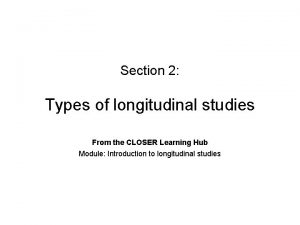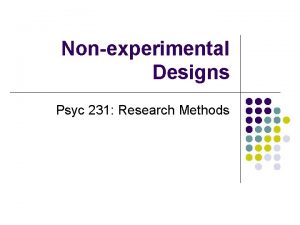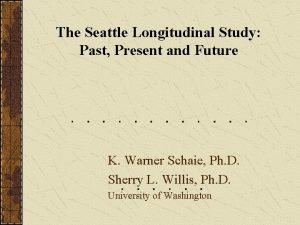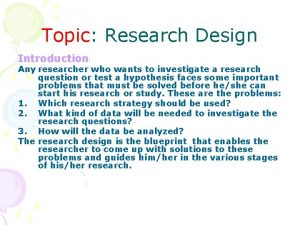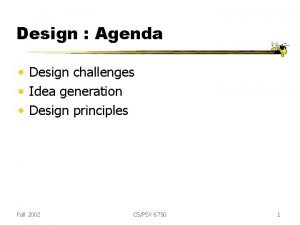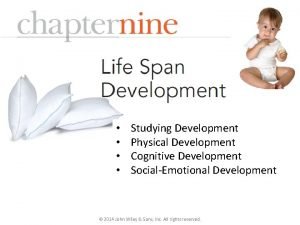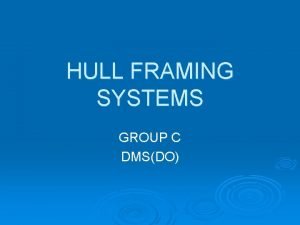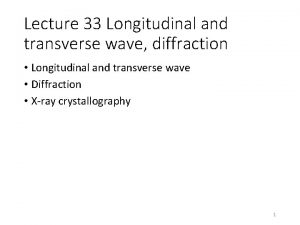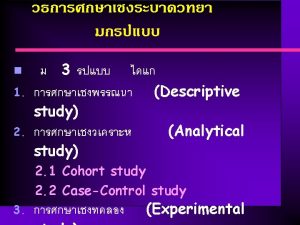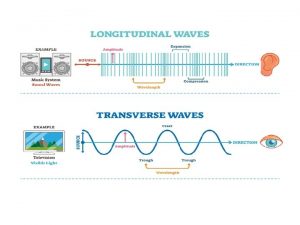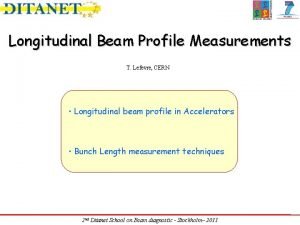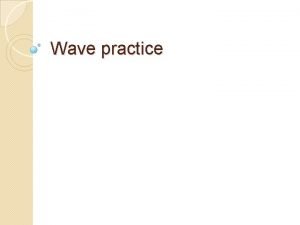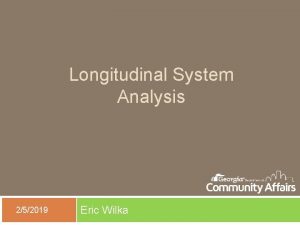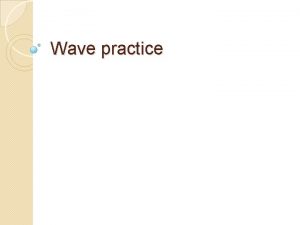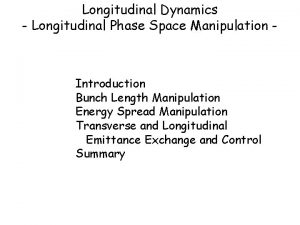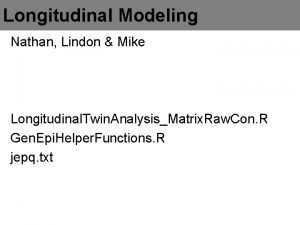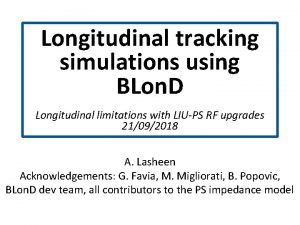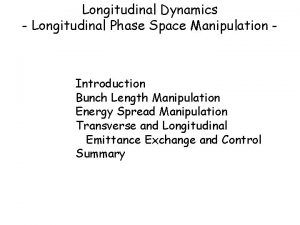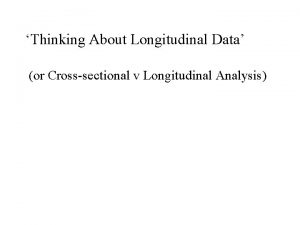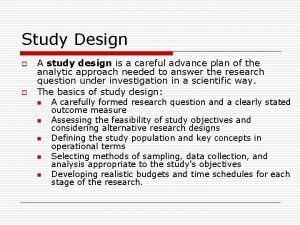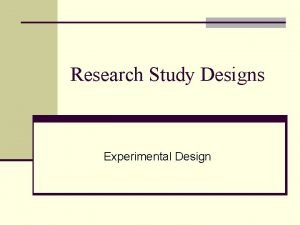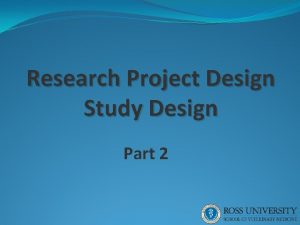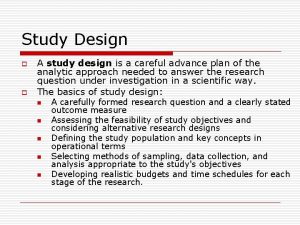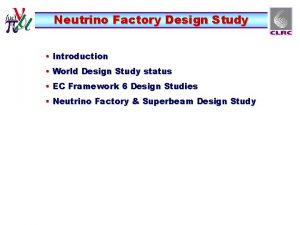Lecture 12 Agenda Longitudinal study design and longitudinal







































- Slides: 39

Lecture 12

Agenda • Longitudinal study design and longitudinal data • Within subject correlation • Summarizing Longitudinal Data • Basic Technique – Analysis of Response Profiles

Motivation • What is a longitudinal study design? – Follow subjects over time – Observe and record events of interest – Prospective cohort study is a longitudinal study design • Statistical definition of longitudinal data refers to measurement of an outcome within a subject multiple times during a study period. – Multiple outcomes recorded on a person – The time of measurement is recorded – Relevant covariate measurements of interest recorded at baseline and possibly repeatedly

Motivation • The goals of a longitudinal data analysis are to: 1. Characterize the pattern of change over time in subjects and in the target population. 2. Characterize differences in the pattern of change over time between subpopulations of interest. • A key difference between longitudinal data and crosssectional data is the presence of within subject correlation.

Motivation • Within subject correlation – measurements are generally clustered within subjects • Measurements on the same subject tend to be positively correlated (more similar). • Failure to account for within subject correlation will lead to incorrect standard errors, invalid inference.

Motivation • Paired t-test vs. Independent Samples t-test • The numerator of the t-statistic is the same • The denominator will be smaller if r 10 > 0 (positive within subject correlation). – Independent samples t-test will choose H 0 in cases where the effect is significant (loss of power).

Population Average (PA) Model • Focus is on comparing the average trend over time between subpopulations. – Comparing exposure groups, treatment groups, etc… • Interpretation follows the same conventions we have developed for cross-sectional data. • Example: Is the pattern of change in an outcome the same for treatment groups?

Population Average (PA) Model • Within subject correlation is viewed as a nuisance parameter – necessary for proper inference but not typically of primary scientific interest • Primary interest usually involves between subject covariates – Covariates whose values vary across individuals in a study as opposed to within individuals.

Random Effects Model • Unobservable features of each subject’s profile represented through random effects. • All observations on a given subject share the same random effect, inducing within subject correlation. • Example: – Random Intercepts and Random slopes

Random Effects Model • Random effects models can be interpreted as population average models for continuous outcomes. • For binary or count outcomes, they are considered subject specific models – Covariate effects do not compare subpopulations. – Covariate effects compare individuals with given covariate pattern.

Population Average Model 1. Mean structure – how does the average outcome change over time? – Linear, quadratic, indicator variables 2. Correlation structure – how are outcomes measured on the same subject correlated? – Unstructured, compound symmetry, AR-1 3. Variance structure – how does the variance change over time? – Variance is/isn’t constant over time

Mean Structure • This is generally a regression model for the average outcome changes over time. – Analysis of Response Profiles: treats time as categorical, use two-way ANOVA with time and treatment. – Parametric: treats time as continuous, assumes a linear, quadratic, or other specified trend.

Correlation Structure • Dependence of measurements within subjects is typically represented in the form of a correlation matrix (or covariance matrix). • Example of a correlation matrix shown below for four time points.

Correlation Structure • Most general correlation structure is the unstructured form (shown on previous slide). – Separate parameter for each pair of time points. – Becomes cumbersome when subjects not observed at common time points • Variance structure is generally either constant or heteroskedastic. • Important to carefully consider correlation and variance structure as they can have substantial influence on standard errors of the mean structure.

Correlation Structure • Other options for covariance structure are shown below:

Example • Longitudinal study of postnatal depression comparing treatment to placebo. • Data collected monthly twice before treatment (baseline) and six times post-baseline (after randomization). • Goal is to compare change in mean depression scores over time. – Is there a different pattern of change for treated subjects vs. placebo?

Data Format • Data structure for proc mixed must be in long format.

Profile Plots • To visualize the trends in each group use profile plot. • Both groups tend to decline over time. • Decline is steeper for treatment group.

Spaghetti Plots • Longitudinal data collected in clusters where the observations within clusters are ordered over time. • Useful to visualize what individual subject profiles look like. • Plot is very busy, but we can see a clear decreasing trend for the individual profiles.

Primary Hypothesis • Fundamental goal of longitudinal study – Does the pattern of change differ between groups? • H 0: parallel mean profiles • H 1: non-parallel mean profiles • This works out to being a test of group by time interaction. • It is typically the primary test of interest in longitudinal studies of this kind.

Primary Hypothesis • Parallel profiles suggests that group effect is the same for all time points. – Treatment and placebo groups have the same pattern of change. • Non-parallel profiles suggests that the group effect is different at each time point. – Treatment group has different pattern of change than placebo. • Test of interaction between group and time provides us with the test of parallel profiles. – Common effects model parallel profiles (fail to reject H 0) – Interaction model group specific profiles (reject H 0)

Analysis of Response Profiles • Nonparametric Mean structure: – Specify group and time as categorical (class statement), and include a group by time interaction. • Covariance (correlation) structure: – Unstructured covariance matrix – Separate correlation parameter for each pair of time points – Separate variance parameter for each time point

Proc Mixed • Method=REML specifies method for estimating correlation/variance parameters. • S = solution prints parameter estimates table • chisq hypothesis tests based on Chi-square instead of F-tests • Repeated statement specifies the form of the covariance matrix. – Use time to ensure observations are ordered by time – Subject=idno specifies clustering by idno – Type=un unstructured covariance matrix

Proc Mixed • Group*time interaction test significant (X 2 = 23. 77, p =. 0013) • Reject the hypothesis of parallel profiles. – Common effects model not valid. • Conclude that the profiles differ by group.

Proc Mixed • If one rejects the null hypothesis of parallel profiles, then it may be of interest to determine specific time points where there is a difference. • When time is categorical, may use estimate statement as follows to obtain desired output concisely.

Proc Mixed • Treatment reduces depression scores at all post baseline points.

Proc Mixed • An easier way to code this is to use the lsmeans statement, but it may be harder to read output when there are many time points. • Diff option calculates difference between all possible pairs of group and time point. – We are only interested in a small subset of these pairings.

Proc Mixed • Need to scroll through entire output to find comparisons where group 1 is compared to group 0 at the same time points (1, 2, …, 8).

Linear Trend Model • The nonparametric mean structure is very flexible, captures many forms well. • Less powerful when the trend is well approximated by parametric form such as linear. • A linear trend captures the group*time interaction with one parameter, whereas the nonparametric approach requires (G-1)*(T-1).

Linear Trend Model • From the profile plot shown earlier, a linear trend may be reasonable for this problem.

Linear Trend Model • Group*time interaction will specify a linear trend for each group. – Intercept and slope are different for each group. • Test of parallel profiles similar to interaction in ANCOVA. • Treat time as continuous (leave it out of class statement).

Linear Trend Model • Variable timecat is a copy of time. Used to keep order of observations with missing data. • Time is not included in the class statement here thus it is treated as continuous.

Linear Trend Model • Group*time interaction test significant (X 2 = 8. 08, p =. 0045) • Note that this test only requires 1 df whereas the nonparametric test required 7 df. • Reject the hypothesis of parallel profiles. – Common effects model not valid. – Conclude that the profiles differ by group.

Linear Trend Model • Lsmeans easier to use with continuous time.

Covariance Structures • It is possible to use different covariance structures that are simpler than unstructured (e. g. compound symmetry, AR-1). – Recommended to use empirical option in these cases. • Compare fit of the covariance structures using AIC, select model with lowest AIC. • Proper modeling of covariance structure not needed if data are missing completely at random. • If data are missing at random, it is important to choose covariance structure carefully. – Incorrect model can lead to biased estimates.

Impact of Within Subject Correlation • What do we gain from modeling within subject correlation? • Showed earlier that the standard errors are reduced in the case of paired data. • Comparison to two-way ANOVA assuming independence.

Impact of Within Subject Correlation • Point estimates are similar. • Standard error estimates are different when we account for within subject correlation in proc mixed. • Group*time p-value smaller with proc mixed.

Analysis of Response Profiles • Advantages: – Treating time as a categorical factor allows for flexible accommodation of many different trajectory shapes. – Allows a variety of within subject covariance patterns. – Can handle unbalanced data when observations are missing completely at random.

Repeated Measures Data • Disadvantages: – Cannot handle misaligned time points. – Modeling becomes cumbersome for designs with many time points (too many parameters). – If data are not missing completely at random, results may be biased. • As we’ll see next week, random effects models alleviate many of these disadvantages.
 01:640:244 lecture notes - lecture 15: plat, idah, farad
01:640:244 lecture notes - lecture 15: plat, idah, farad Agenda sistemica y agenda institucional
Agenda sistemica y agenda institucional Longitudinal study qualitative or quantitative
Longitudinal study qualitative or quantitative Cross sequential study
Cross sequential study Cross sectional study
Cross sectional study Sequential vs longitudinal study
Sequential vs longitudinal study What is longitudinal study in psychology
What is longitudinal study in psychology Longitudinal prospective study
Longitudinal prospective study Stability vs change ap psychology
Stability vs change ap psychology Difference between case control and cohort study
Difference between case control and cohort study Seattle longitudinal study findings
Seattle longitudinal study findings Longitudinal research design example
Longitudinal research design example Vcaa visual communication design
Vcaa visual communication design Eurocode reinforcement detailing
Eurocode reinforcement detailing Urban design lecture
Urban design lecture Principles of design in interior design ppt
Principles of design in interior design ppt Lecture hall background
Lecture hall background Game design lecture
Game design lecture Computer aided drug design lecture notes
Computer aided drug design lecture notes Cmos vlsi design lecture notes
Cmos vlsi design lecture notes Agenda design ideas
Agenda design ideas Draw and label a longitudinal wave
Draw and label a longitudinal wave Transverse and longitudnal waves
Transverse and longitudnal waves What is work study in management
What is work study in management Distinguish between motion study and time study
Distinguish between motion study and time study Differentiate between time study and motion study
Differentiate between time study and motion study Anxious ambivalent attachment
Anxious ambivalent attachment Longitudinal research and cross sectional research
Longitudinal research and cross sectional research Framing system of the ship
Framing system of the ship Framing system in ship construction
Framing system in ship construction Mesa and scarp terrain
Mesa and scarp terrain Longitudinal and transverse waves
Longitudinal and transverse waves Transverse wave and longitudinal wave example
Transverse wave and longitudinal wave example Case series
Case series Retrospective cohort study vs prospective cohort study
Retrospective cohort study vs prospective cohort study Marty lobdel
Marty lobdel Phytogeographical regions
Phytogeographical regions Religion and society vce
Religion and society vce Outdoor ed study design
Outdoor ed study design Feasibility
Feasibility




